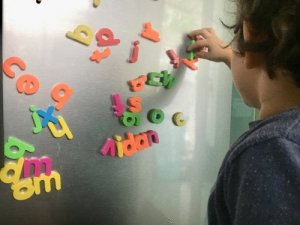11 Tips to Improve Your Child's Spelling


Written and verified by the psychologist María Alejandra Castro Arbeláez
If you want to improve your child’s spelling, then as a parent, you’ll need to work hand in hand with your child’s teachers.
For children to get better at spelling, they’ll need to reinforce aspects such as phonological and morphological awareness and to understand the dynamics of language. Once they’ve reached maturity in these aspects, then you can implement activities and strategies.
“The process of acquiring orthography is often a long and difficult one, so it must be initiated in the early years of Primary education and reinforced in all subsequent years. In this process, important aspects intervene, such as memory, attention, the capacity of relationships and the association of elements and the sense of rhythm”.
– Florentino Paredes –
Depending on the approach you want to adopt, the activities to improve your child’s spelling can vary. Here are some options to put into practice depending on your child’s preferences and interests.
How to improve your child’s spelling using traditional methods
- Use of a dictionary. Teaching your children to use the dictionary not only allows them to check the correct spelling of words, but also motivates reading and the enthusiasm to find out more. To increase their enjoyment, you can use interactive or illustrated versions.
- Writing letters. A more effective variant of traditional dictation is to ask children to write a text. In this way, you can identify and correct mistakes, and provide positive feedback.
- Phonological and morphological awareness exercises. Distinguishing phonemes, syllables, and word structure helps children to understand the reason for the different rules. A good exercise is to form families of words that share the same roots and then modify them to show the child how they’re transformed.
- Copy method. A common, but monotonous, practice for some children is to rewrite the word that causes them problems until they’re able to memorize how it’s spelled. At times this may work, but it shouldn’t be the only method you use.

The multisensory method
This method, proposed by Forgione, and subsequently reinforced by other authors, consists of four phases:
- Visual phase. We perceive the word and identify the graphemes and the syllabic separation. At this stage, it’s advisable to use bright colors to facilitate the association of concepts.
- Auditory phase. At this stage of the process, we associate the image with the sound of the word. At home, you’ll need to show the child the proper pronunciation and articulation of the word while showing them the graphical representation at the same time.
- Gnostic phase. You’ve already worked on the phonetics and formed the concept. It’s now time to teach them the meaning of the word and show them with examples of how it can be used, and in what context.
- Motor phase. The final phase is the production phase and this should only take place when the child has already understood the spelling through different channels. Acquiring motor memory implies the systematic repetition of the forming of the word and, if necessary, the corrections.
Other effective exercises to improve your child’s spelling
- Magnetic letters. Offer them the possibility of using magnetic letters in different colors and sizes. There are many different options here. You can give them a few letters and ask them to form words or show them a picture and ask them to spell an object they see. Alternatively, you can tell them to spell their name, or, finally, you could give them a very short dictation. This is a very effective and fun exercise for children of different age groups.

- Use sand or shaving foam. Either put sand in a container or shaving cream on a flat surface. With their fingers, they should write down all the words you tell them and you can make corrections when necessary. Children learn through their senses and this is a fun way to do it.
- Cultivate the habit of reading. Without a doubt, the best way to learn to write and use words is to read them repeatedly. Use storytime at bedtime to help your children learn at least one word per night. In addition to significantly expanding their vocabulary, they’ll improve their writing habits.
With these simple activities and recommendations, you’ll be able to improve your child’s spelling at home. None of them are time-consuming exercises, and the fact that they’re good fun will certainly have a positive impact on your child’s academic life and communication.
If you want to improve your child’s spelling, then as a parent, you’ll need to work hand in hand with your child’s teachers.
For children to get better at spelling, they’ll need to reinforce aspects such as phonological and morphological awareness and to understand the dynamics of language. Once they’ve reached maturity in these aspects, then you can implement activities and strategies.
“The process of acquiring orthography is often a long and difficult one, so it must be initiated in the early years of Primary education and reinforced in all subsequent years. In this process, important aspects intervene, such as memory, attention, the capacity of relationships and the association of elements and the sense of rhythm”.
– Florentino Paredes –
Depending on the approach you want to adopt, the activities to improve your child’s spelling can vary. Here are some options to put into practice depending on your child’s preferences and interests.
How to improve your child’s spelling using traditional methods
- Use of a dictionary. Teaching your children to use the dictionary not only allows them to check the correct spelling of words, but also motivates reading and the enthusiasm to find out more. To increase their enjoyment, you can use interactive or illustrated versions.
- Writing letters. A more effective variant of traditional dictation is to ask children to write a text. In this way, you can identify and correct mistakes, and provide positive feedback.
- Phonological and morphological awareness exercises. Distinguishing phonemes, syllables, and word structure helps children to understand the reason for the different rules. A good exercise is to form families of words that share the same roots and then modify them to show the child how they’re transformed.
- Copy method. A common, but monotonous, practice for some children is to rewrite the word that causes them problems until they’re able to memorize how it’s spelled. At times this may work, but it shouldn’t be the only method you use.

The multisensory method
This method, proposed by Forgione, and subsequently reinforced by other authors, consists of four phases:
- Visual phase. We perceive the word and identify the graphemes and the syllabic separation. At this stage, it’s advisable to use bright colors to facilitate the association of concepts.
- Auditory phase. At this stage of the process, we associate the image with the sound of the word. At home, you’ll need to show the child the proper pronunciation and articulation of the word while showing them the graphical representation at the same time.
- Gnostic phase. You’ve already worked on the phonetics and formed the concept. It’s now time to teach them the meaning of the word and show them with examples of how it can be used, and in what context.
- Motor phase. The final phase is the production phase and this should only take place when the child has already understood the spelling through different channels. Acquiring motor memory implies the systematic repetition of the forming of the word and, if necessary, the corrections.
Other effective exercises to improve your child’s spelling
- Magnetic letters. Offer them the possibility of using magnetic letters in different colors and sizes. There are many different options here. You can give them a few letters and ask them to form words or show them a picture and ask them to spell an object they see. Alternatively, you can tell them to spell their name, or, finally, you could give them a very short dictation. This is a very effective and fun exercise for children of different age groups.

- Use sand or shaving foam. Either put sand in a container or shaving cream on a flat surface. With their fingers, they should write down all the words you tell them and you can make corrections when necessary. Children learn through their senses and this is a fun way to do it.
- Cultivate the habit of reading. Without a doubt, the best way to learn to write and use words is to read them repeatedly. Use storytime at bedtime to help your children learn at least one word per night. In addition to significantly expanding their vocabulary, they’ll improve their writing habits.
With these simple activities and recommendations, you’ll be able to improve your child’s spelling at home. None of them are time-consuming exercises, and the fact that they’re good fun will certainly have a positive impact on your child’s academic life and communication.
All cited sources were thoroughly reviewed by our team to ensure their quality, reliability, currency, and validity. The bibliography of this article was considered reliable and of academic or scientific accuracy.
- del Moral Pérez, M. E., García, L. C. F., & Guzmán-Duque, A. P. (2016). Proyecto game to learn: aprendizaje basado en juegos para potenciar las inteligencias lógicomatemática, naturalista y lingüística en educación primaria. Píxel-Bit. Revista de Medios y Educación, (49), 173-193. https://www.redalyc.org/pdf/368/36846509013.pdf
- Díaz, M. R. (2008, año 33).”Preocupaciones docentes y enfoque didáctico de la enseñanza de la ortografía”. Docencia e Investigación: Revista de la Escuela Universitaria de Magisterio de Toledo, nº 18, 43-50.
- Díaz Perea, M. D. R., & Manjón Cabeza Cruz, A. (2010). Enseñanza y procesos de mejora en el aprendizaje ortográfico. https://ruidera.uclm.es/xmlui/handle/10578/8313
- Gabarró, D. (2012). Dominar la ortografía. D. Gabarró, Dominar la ortografía, 34-38.
- Hernández Rincón, J. C. (2016). Pautas para mejorar la ortografía en casa en niños de 5 a 10 años. https://repository.unad.edu.co/handle/10596/6296
- Vargas Padilla, J. B., & Bravo Meza, M. M. (2011). Estrategias metodológicas en el aprendizaje significativo de la ortografía (Bachelor’s thesis). http://repositorio.unemi.edu.ec/bitstream/123456789/980/3/ESTRATEGIAS%20METODOL%c3%93GICAS%20EN%20EL%20APRENDIZAJE%20SIGNIFICATIVO%20DE%20LA%20ORTOGRAFIA.pdf
This text is provided for informational purposes only and does not replace consultation with a professional. If in doubt, consult your specialist.








